
THE JOURNEY FROM A BUSTLING FOREST COMMUNITY TO SOLITARY LIFE IN YOUR LIVING ROOM


The grey parrot is one of Africa’s treasures, and seeing them bank and wheel in the skies in noisy flocks or chatter in the canopies as they forage is a delight and privilege. They surely represent freedom in its purest form. But grey parrots are also the epitome of life behind bars. These intelligent, enigmatic birds are perhaps best known as the feathered entertainers that chirp, wolf-whistle and mimic their way into our hearts from cages in homes across the globe. So this is the story of a special bird vanishing from Africa’s forests as fast as morning mist under a tropical sun and how our fascination for a species can lead to its extermination from the wild.
The history of the grey parrot’s domestication dates at least as far back as 2000 BC, with Egyptian hieroglyphics depicting grey parrots as pets. The ancient Greeks also valued them, as did wealthy Romans who often kept them in ornate cages.
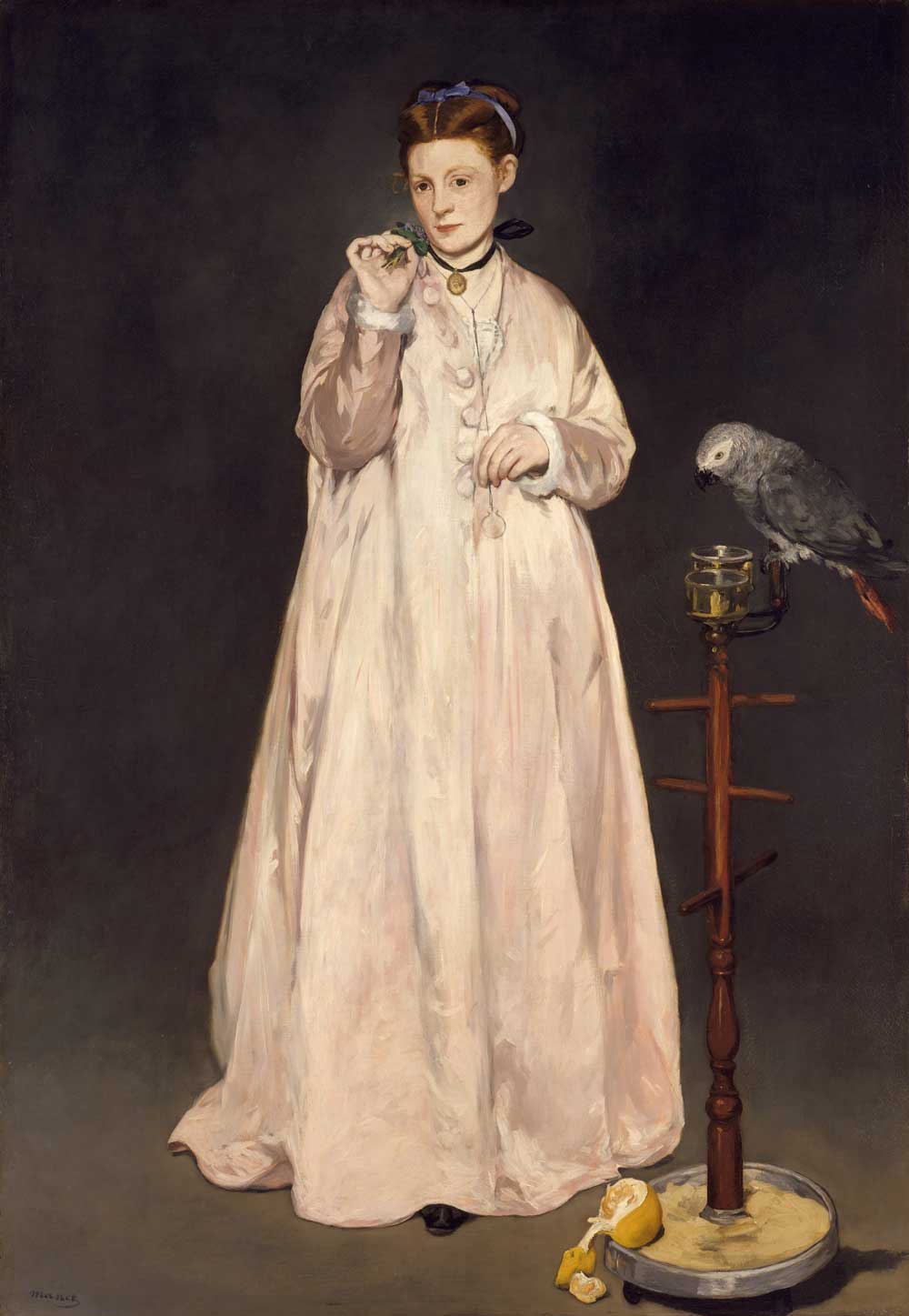
There are two distinct species. The one we know best is the Congo grey parrot that, as the name suggests, lives in the forests of the Republic of Congo and the Democratic Republic of Congo (DRC). Its range extends from western Kenya to Ivory Coast and includes the islands of São Tomé & Príncipe and Bioko.
The lesser known Timneh grey parrot is slightly smaller with charcoal grey colouring, a darker maroon tail, and a light, horn-coloured area on the upper mandible. Timneh parrots are endemic to the western forests of the Guinean shield, from Guinea-Bissau, Guinea, Liberia, Sierra Leone and Ivory Coast. Not much is known about this species, and many experts fear the population has been severely depleted, placing it in an even more serious position than its better-known cousin.
The grey parrot has been heavily trapped for over a century, making it the most traded wild-caught parrot listed under CITES. It is listed in CITES Appendix II, which means that trade should be controlled to avoid utilisation incompatible with survival in the wild. The grey parrot is also classified as vulnerable on the IUCN Red List, meaning there is a ‘high risk of extinction in the wild.’
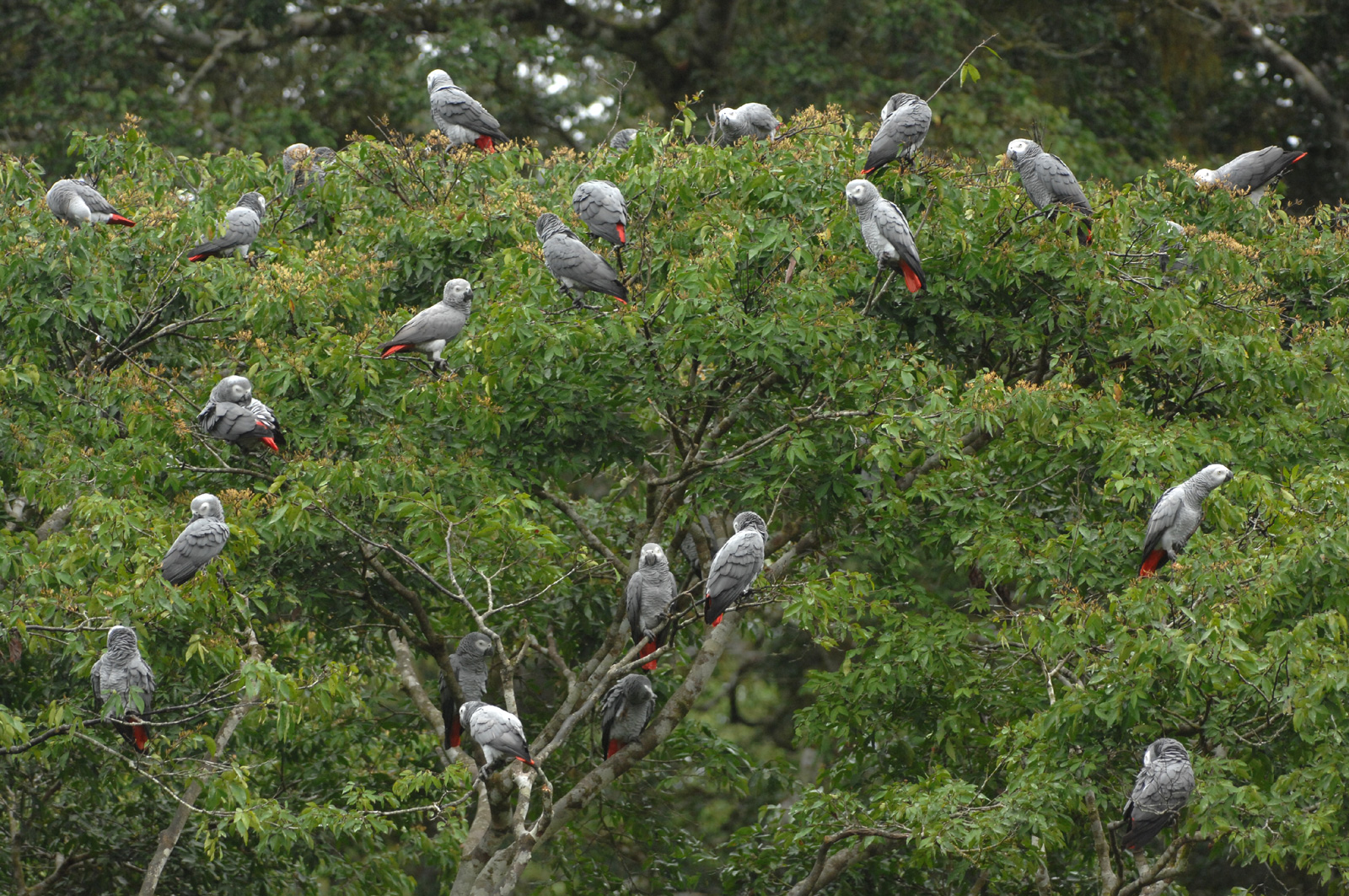
Over 1.36 million grey parrots (including Timnehs) have been legally exported since 1975, but factoring in mortality rates before export of 33-60%, the number of parrots harvested from the wild to supply the legal trade could top 3 million. The high level of trade has been fraught with violations from CITES member countries, exports from non-range countries, abuse of export permits with quotas repeatedly exceeded, wild-caught parrots falsely declared captive-bred, and continued trade despite zero quota recommendation by CITES.
Trapping for the pet trade has probably been underway in DRC since the early colonial era. Today, various officials play some role in authorising and taxing the trade here but have little impact on regulating capture or transport.
The grey parrot’s journey from a bustling forest community to a solitary existence in a living room is a long one fraught with danger and death. According to John Hart, the scientific director of Lukuru Wildlife Foundation in DRC, trappers operate at various sites using a range of methods – most commonly trapping along frequently-used fly corridors or at points of aggregation. Large numbers of birds are netted at clearings, where they come to ground to drink or ingest soil. Fledglings are often harvested from nests, and live or wooden decoys lure flying parrots in oil palms, where they are trapped on glue-covered perches as they come in to feed. Oil palms are part of their natural diet.
They are then sold to local buyers who fill orders from exporters based in Kinshasa. In a tragic irony, the parrots spend much of their incarceration in the air with other birds. They are crammed into small containers in Kindu and Kisangani, where Hart focuses most of his research, and then flown to the capital by light plane. The birds are rarely transported by boat or vehicle due to inaccessibility and the high mortality rate.
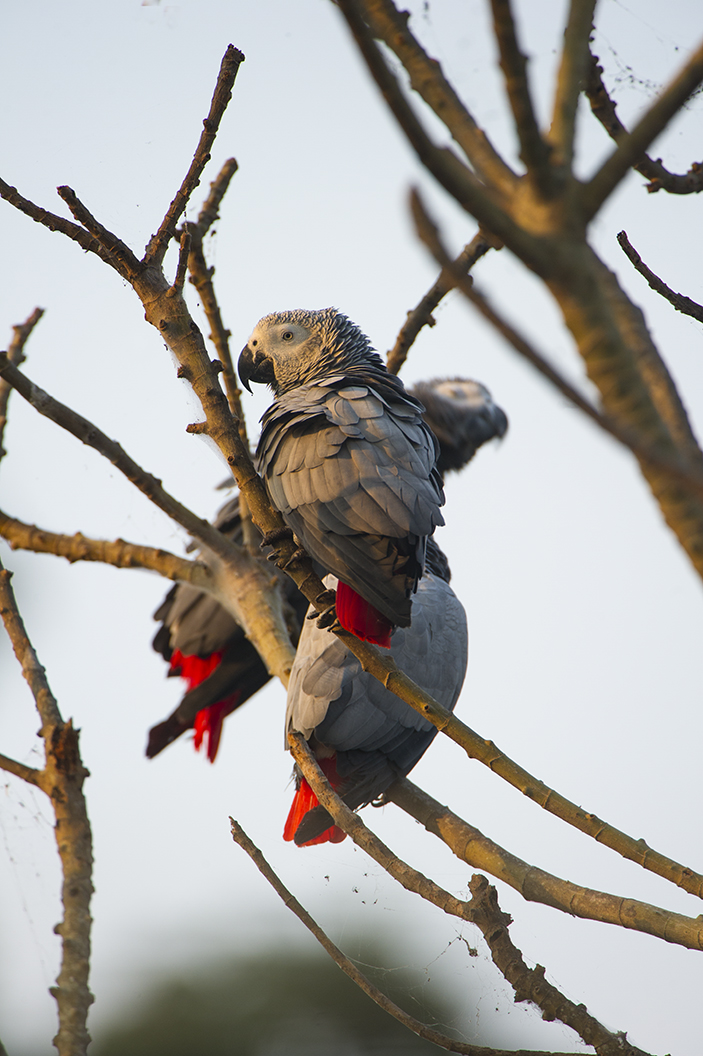

Middle: Parrots are tethered to palm trees to attract other parrots for trappers in Kisangani, DRC.
Bottom Left: A wild-caught parrot is put in a small cage for transport.
Bottom Right: Fledglings plucked from tree holes for the parrot trade. ©Lukuru Foundation/TL2 Project
About half of the parrots captured for the pet trade die before they reach Kinshasa
Hart calculates that at least 10% of birds die on planes, 24% die while being transported over long distance or when caught as fledglings, and between 10% and 40% die in the hands of local buyers. This reveals that approximately 50% of the birds die before they even reach Kinshasa. And those survivors still have a long, perilous journey ahead.
A 2006 EU import ban on wild birds means grey parrots are no longer transported to Europe, but CITES continues to support export from DRC, Congo, and Cameroon to South Africa, South East Asia and the Persian Gulf. There is rising demand for grey parrots in China, and the presence of Chinese business interests in range countries probably creates avenues for both illegal and legal trade.
South Africa is proving increasingly irresistible to traders, with its toxic combination of excellent infrastructure, porous borders and high levels of fraud and corruption. In 2010, 731 grey parrots died en route by plane from Kinshasa to Durban. Speculation is that they were linked to the “Congo 500” – illegal parrots that had been seized in DRC and taken to a sanctuary for rehabilitation and release back into the Congo forests. They were confiscated from the sanctuary by government officials and then disappeared back into the system.

South Africa plays an increasing role in the trafficking of grey parrots (and many other African wildlife species). It has, over the last few years, consistently imported more from DRC than that country’s entire export quota of 5,000 grey parrots.
Not to be overlooked is the number of grey parrots South Africa exports as captive-bred – close to 42,000 in 2012. With this level of captive breeding capacity, there is little justification for the continued import of wild parrots into South Africa, a practice with devastating consequences for wild populations. There is also high mortality in South Africa’s captive exports. The intense breeding practices are a vehicle for diseases, and a large number of the captive-bred greys are affected by the often deadly PBFD (Psittacine Beak and Feather Disease) and other diseases.
Many breeders portray themselves as saviours of wild parrots by producing captive-bred stock and thus supposedly obviating the need to capture wild birds. Yet wild populations are under even more pressure to feed the growing parrot captive breeding industry.
Wild populations are under pressure to feed the pet industry with cheap breeding stock
Wild-caught birds (especially illegal birds) are cheaper than captive-bred birds, so a wild-caught bird is quicker and easier to sell. In addition, many breeders prefer wild-caught birds because they commence breeding almost immediately, whereas captive-bred birds only reach breeding age after four years. To increase yield, breeders often hand-raise fledglings that had been hatched in incubators, thereby robbing the birds of essential life skills handed down by parents. The result is a tame parrot, suitably conditioned for pet purposes but of little use as a breeder – further increasing demand for wild-caught birds as breeding stock.

Experts say the grey parrot is so smart that it can perform cognitive tasks at the level of human toddlers, which is one of the properties that makes them so attractive as pets. But most pet parrots are kept alone in cages, whereas in the wild, they are social birds – hard-coded to seek the comfort and security of their peers, roosting in groups and flying in large flocks. Many pet grey parrots end up as well-loved companions, but many more end up unwanted, misunderstood and socially maladjusted – often given away to friends, relatives or rescue centres.
A grey parrot lives for 50-60 years in captivity, which is something many prospective owners don’t fully comprehend. Every responsible parrot owner should have a succession plan – someone reliable to carry on the commitment and relationship.
I would imagine both wild-caught and captive-bred parrots struggle to adjust to a life of solitary confinement in a cage or house a fraction of the size of their natural range. There is also the constant need for humans to prod, pick up, stroke and cuddle their pets, which must be stressful to birds not used to this form of close combat. Paramount is a lack of comprehension about their diet.
Many captive grey parrots end up obese, socially awkward “problem children”
The tradition is to feed pet parrots dry seed, fleshy fruit with no nutritious kernel or “scientifically prepared” biscuits – whereas, in nature, the parrot will commonly feed off a wide array of fresh food, especially the kernels of forest fruit (the flesh is mostly discarded). Unsurprisingly, many grey parrots end up obese, socially awkward “problem children” growling, swearing and screaming at strangers, biting fingers and chewing furniture. And, unfortunately for the naïve purchaser, they don’t become well-adjusted adults at any stage of their lifetime. With the best of intentions, it’s often a lose-lose relationship for parrots and their owners.
Some wild-caught grey parrots are lucky to escape such a future. Parrots seized in Bulgaria were rehabilitated and released by the World Parrot Trust on Ngamba Island, Uganda, in July 2013. The parrots were caught illegally in DRC, shipped to Lebanon (where they were issued with fake papers) and then shipped to Bulgaria. 108 parrots arrived in Bulgaria, but only 17 survived the quarantine imposed by Bulgarian authorities who were poorly equipped for the task. The process of international bureaucracy and rehabilitation took over 3 years before the 17 survivors tasted freedom again.
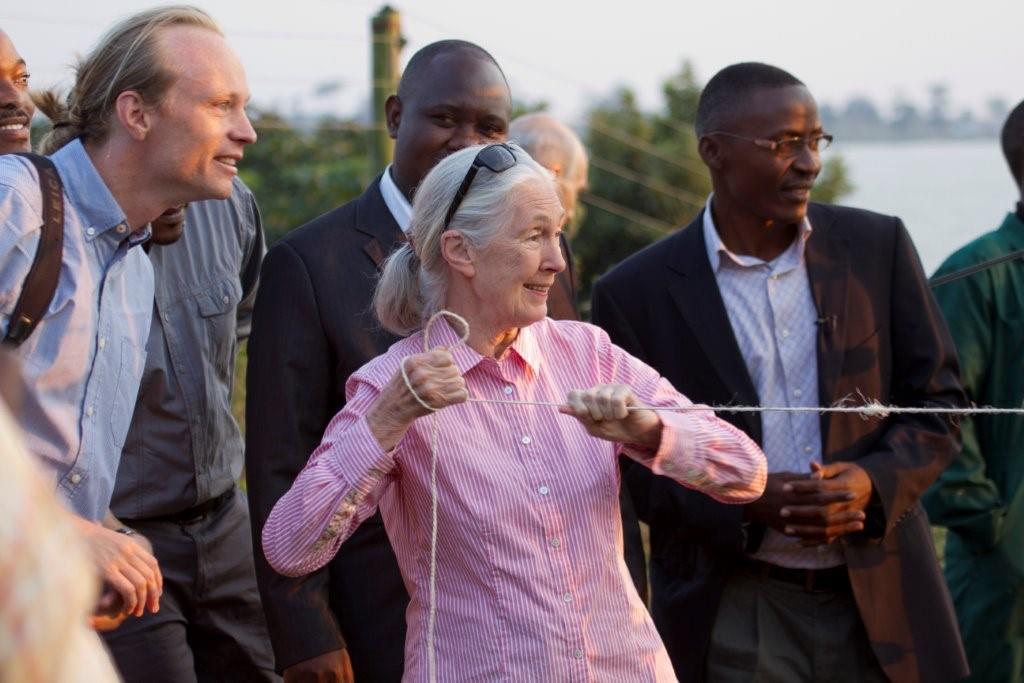
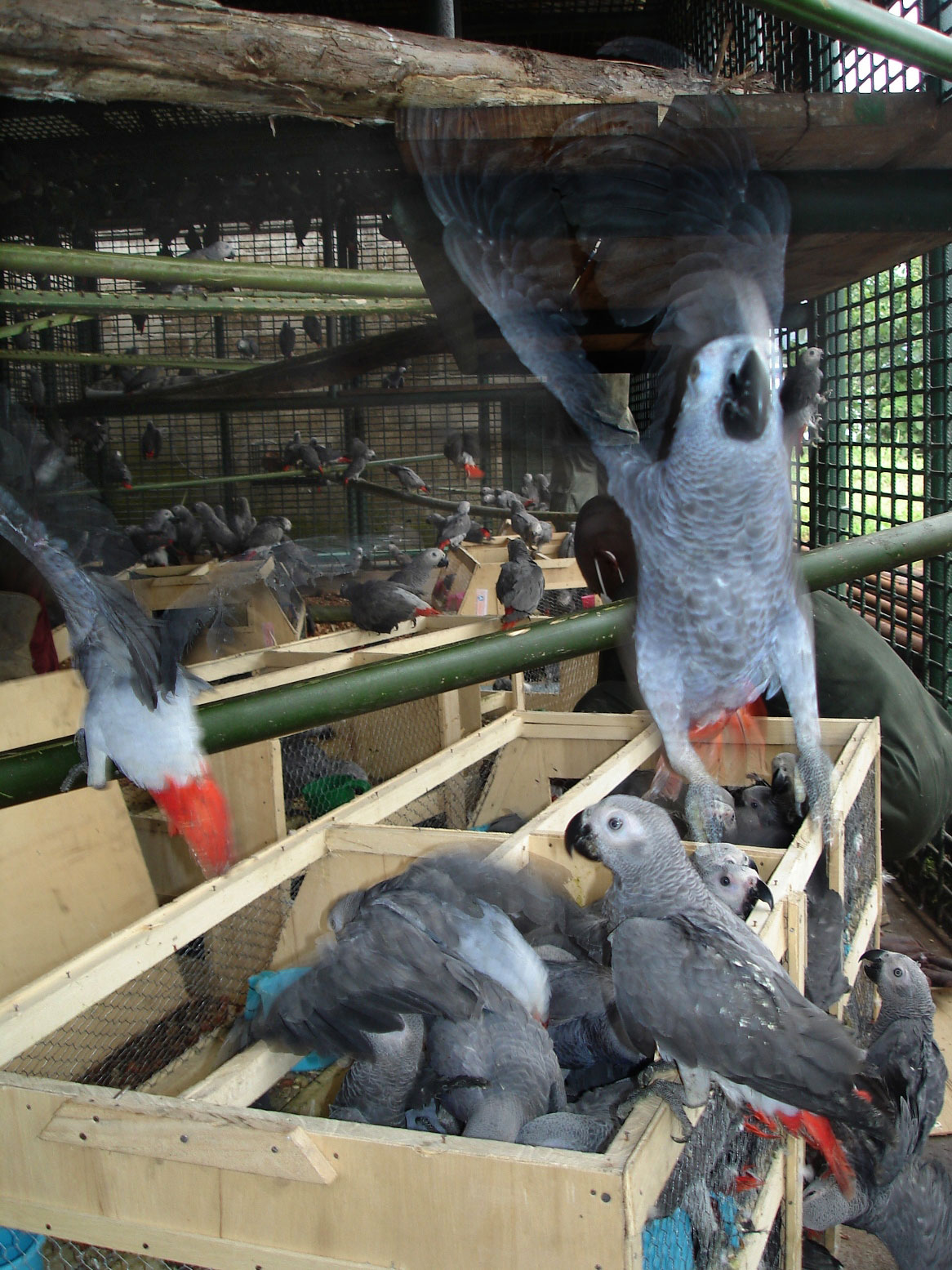
Bottom: Parrots are released into a holding pen in Cameroon before release into the wild. ©WPT
This iconic bird is clearly under pressure in the wild from habitat loss and from trapping for the pet trade. The proportion of birds dying en route from capture to the market appears very high, and we have no idea of true wild population numbers. CITES has little control over the situation, and member countries view the grey parrot as an inexhaustible harvest resource for revenue and employment.
A positive sign is that thousands of grey parrots have been confiscated from traffickers in several African countries, including Kenya, Uganda, Cameroon, DRC, the Republic of Congo, and Guinea. In special cases, these birds have been successfully released into their former ranges. These confiscation efforts, spearheaded by the World Parrot Trust and many other collaborating NGOs and governments, are proving a valuable deterrent and a source of birds for the restoration of the species in the wild. But much more needs to be done.
South Africa should be a conservation leader of grey parrots. There are more than enough birds in captivity to sustain a healthy gene pool for the pet trade. It should cease all imports of wild-caught grey parrots while applying stricter controls against the illegal trade. Do CITES and member countries have the political will and control over the situation to take this necessary action?
The information in this article was gathered from personal observations and experience, advice and info provided by experts and various print and online resources. Most specifically, I would like to list the following invaluable resources:
1. Rowan Martin, manager of World Parrot Trust’s African Conservation Program, for his advice, guidance and proof-reading skills.
2. John and Terese Hart, of the Lukuru Foundation in Kinshasa, Democratic Republic of Congo.
3. Cristiana Senni and Jamie Gilardi of World Parrot Trust.
4. Mike Perrin, whose book “Parrots of Africa, Madagascar and the Mascarene Islands” was an invaluable resource.
ALSO READ: Get to know the grey parrot
Contributors
 SIMON ESPLEY is a proud African, of the digital tribe, and honoured to be CEO of Africa Geographic. His travels in Africa are searching for wilderness, real people with interesting stories and elusive birds. He lives in Hoedspruit, next to the Kruger National Park, with his wife Lizz and 2 Jack Russells. When not travelling or working he is usually on his mountain bike somewhere out there. He qualified as a chartered account, but found his calling sharing Africa’s incredibleness with you. His motto is “Live for now, have fun, be good, tread lightly and respect others. And embrace change”.
SIMON ESPLEY is a proud African, of the digital tribe, and honoured to be CEO of Africa Geographic. His travels in Africa are searching for wilderness, real people with interesting stories and elusive birds. He lives in Hoedspruit, next to the Kruger National Park, with his wife Lizz and 2 Jack Russells. When not travelling or working he is usually on his mountain bike somewhere out there. He qualified as a chartered account, but found his calling sharing Africa’s incredibleness with you. His motto is “Live for now, have fun, be good, tread lightly and respect others. And embrace change”.
 DR. ROWAN MARTIN has been of vital assistance in writing this issue. Rowan heads up the World Parrot Trust’s African Conservation Program. He first became involved with WPT during his doctoral studies on the breeding behaviour of Yellow-shouldered Amazon parrots on Bonaire when he was based at the University of Sheffield, UK. Between 2009 and 2013 he held a Postdoctoral fellowship at the Percy FitzPatrick Institute of African Ornithology at the University of Cape Town, South Africa. While in South Africa he became involved in African parrot conservation and as a co-ordinator for the Africa region of the International Ornithologist’s Union Parrot Researcher’s Group, took a lead role in reviewing the state of research and conservation in African parrots.
DR. ROWAN MARTIN has been of vital assistance in writing this issue. Rowan heads up the World Parrot Trust’s African Conservation Program. He first became involved with WPT during his doctoral studies on the breeding behaviour of Yellow-shouldered Amazon parrots on Bonaire when he was based at the University of Sheffield, UK. Between 2009 and 2013 he held a Postdoctoral fellowship at the Percy FitzPatrick Institute of African Ornithology at the University of Cape Town, South Africa. While in South Africa he became involved in African parrot conservation and as a co-ordinator for the Africa region of the International Ornithologist’s Union Parrot Researcher’s Group, took a lead role in reviewing the state of research and conservation in African parrots.
 CHRISTIAN MEERMANN is the photographer of our Congo grey parrot cover image. Based in Germany and active since 2007, his award winning fine art black & white portraits of animals have not only built a strong and still growing reputation in the photographic communities on the web, but also caught the interest of customers like the Sporting Clube de Portugal, Maxim magazine, Getty Images and Nike. You can find his work on his website and also on FlickR, Google+ and on Twitter.
CHRISTIAN MEERMANN is the photographer of our Congo grey parrot cover image. Based in Germany and active since 2007, his award winning fine art black & white portraits of animals have not only built a strong and still growing reputation in the photographic communities on the web, but also caught the interest of customers like the Sporting Clube de Portugal, Maxim magazine, Getty Images and Nike. You can find his work on his website and also on FlickR, Google+ and on Twitter.
To comment on this story: Login (or sign up) to our app here - it's a troll-free safe place 🙂.![]()






